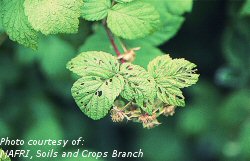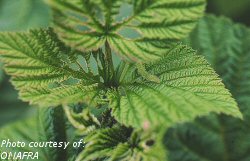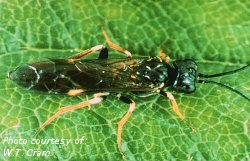Raspberry Sawfly (Monophadnoides Geniculatus)

Raspberry sawfly leaf damage

Raspberry sawfly larva and leaf damage

Raspberry sawfly adult
Host Plants And Distribution
The raspberry sawfly primarily feeds on raspberry, but will also feed on loganberry, blackberry and possibly gooseberry. It is found across Canada and the northern United States. Populations are quite variable.
Biology
The adult sawfly is a small (6 mm) black insect with a yellow band on the abdomen and clear wings. Adults emerge in spring and lay eggs in leaf tissue at the same time as flowering occurs. Larvae begin feeding on the underside of leaves, flower buds, young fruit and growing shoots. Larvae are light green and are covered with white bristles. The larvae have what appear to be many legs (3 pairs of true legs and many leg-like appendages or prolegs). After feeding for about 2-3 weeks, they reach a length of 10-18 mm. They drop to the ground ,where they form a cocoon in the soil. Pupation occurs in the spring and the adults again emerge. There is one generation per year.
Symptoms And Damage
Damage usually consists of minor damage to the leaves in the form of small holes. Occasionally, heavy infestation occurs and leaves are completely skeletonized leaving only the leaf veins.
Scouting Techniques
Visual inspection for the larvae during June will indicate whether numbers are high enough to warrant control.
Economic Thresholds
No economic thresholds have been established for this insect. Control decisions should be based on the amount of leaf damage. Holes in the occasional leaf can be ignored. If leaf skeletonization is occurring, control measures should be implemented.
